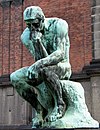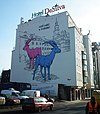Key:artwork_type
Jump to navigation
Jump to search
| Description |
|---|
| Describes the type of an artwork. |
| Group: tourism |
| Used on these elements |
| Documented values: 12 |
| Requires |
| Useful combination |
| Status: approved |
| Tools for this tag |
|
This tag describes the type of an artwork more precisely.
How to map
This tag must be used in combination with tourism=artwork.
Values
See below for suggested tag artwork_type=* usage.
| Value | Description | Photo |
|---|---|---|
| sculpture | A sculpture is a work made of stone, metal, ceramic, wood or other material. If the work represents people or animals, you should use artwork_type=statue instead. | 
|
| statue | A statue is a sculpture representing one or more people or animals (including abstract concepts allegorically represented as people or animals), normally full-length, as opposed to a bust, and at least close to life-size, or larger. A small statue, usually small enough to be picked up, is called a statuette or figurine. See also: historic=memorial + memorial=statue
statue=* |

|
| mural | A mural is any piece of artwork painted or applied directly on a wall, ceiling or other large permanent surface. See also artwork_type=painting and an explanation about the difference. | 
|
| graffiti | A notable graffiti work | 
|
| installation | Interactive and/or site-specific artwork. See |

|
| bust | A bust is a sculpted or cast representation of the upper part of the human figure, depicting a person's head and neck, and a variable portion of the chest and shoulders. The piece is normally supported by a plinth. See also: historic=memorial + memorial=bust | 
|
| stone | An artistically worked stone. | 
|
| painting | A painting is the result of applying paint, pigment or colour to a surface. See also artwork_type=mural. | 
|
| architecture | A noteworthy building or physical structure. | 
|
| mosaic | The artwork is a pattern or image made of small regular or irregular pieces of colored stone, glass or ceramic, held in place by plaster/mortar, and covering a surface. See Mosaic on Wikipedia | 
|
| tilework | A tile [or tilework] is a manufactured piece of hard-wearing material such as ceramic, stone, metal, or even glass, generally used for covering roofs, floors, walls, showers, or other objects such as tabletops. The artwork is built from bigger tiles, with e.g. a painting on them. Also see azulejo
Tile. See Tile on Wikipedia |
 
|
| relief | A sculptural technique where the sculpted elements remain attached to a solid background of the same material. | 
|
| fountain | A fountain | 
|
| streetart or street_art | If the artwork can be classified as https://en.wikipedia.org/wiki/Street_art, but it does not fit into any other category. Usually one should use tags mural or graffiti, although streetart might be a better match in same cases like re-painted 3D objects. street_art is less popular value of the two.
Consider adding artwork_subject=street_art as well in this case |

|
| azulejo | The azulejo refers to a typical form of Portuguese or Spanish painted, tin-glazed, ceramic tilework. They have become a typical aspect of Portuguese culture, manifesting without interruption during five centuries, the consecutive trends in art. Azulejos can be found inside and outside churches, palaces, ordinary houses and even railway stations or subway stations. See |

|
| land_art | A distinctive feature of land art is the absence of references to historical characters, and other symbolic and historical load. Thus, land art should not be confused with |

|
| star | A star-shaped installation embedded into the pavement honouring notable people, animals, fictional characters and others, often forming a part of a |

|
| szekely_gate | Székely gate, a type of Transylvanian traditional wooden arched gate, common in Hungary and Romania. | 
|
| User defined | All commonly used values according to Taginfo. |
Possible tagging mistakes
See also
- man_made=geoglyph — A large design or motif (generally longer than 4 metres) produced on the ground and typically formed by clastic rocks or similarly durable elements of the landscape, such as stones, stone fragments, live trees, gravel, or earth.
- exhibit=* — An object exhibited to the public typically in a museum, gallery or trade fair.
- Add artwork_type=* to artworks based on images. — MapRoulette challenge.
